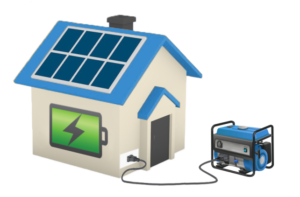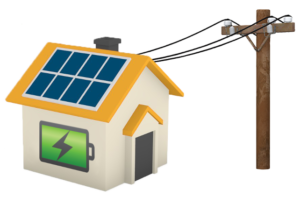With all the technologies, brands, and configurations available for battery storage, it can be tricky to try and decide which battery system is right for you.
We’ve compiled a list of frequently asked questions to try and make things a bit clearer. If you’d like further information or a quote, please contact us today on 1300 334 839 or email info@offgridenergy.com.au

Off grid power systems supply electricity to properties that are not connected to the public electricity network. Sometimes referred to as “stand-alone power systems” (SAPS), or “remote area power systems” (RAPS).


Grid connected battery storage products vary a fair bit, but they all have one thing in common – unlike off-grid systems, these systems still require the property to have a grid connection.
The cost of a battery storage system depends on many factors such as energy requirements, peak power requirements, equipment quality, enabling equipment required (some products have built-in inverters, others don’t), install location (affects STC value), and many others.
For off-grid systems, the biggest factor is how much energy you need.
Generally speaking; small off-grid systems can range from $20,000 to $35,000, most family homes usually range from $35,000 to $70,000, and large or luxury homes can be from $70,000 upwards.
Grid-connected battery systems start at around $20,000.
*Prices are given as general indications only, and we recommend seeking an accurate indication of what a system would cost for your specific needs. These price indications may vary without notice.
If you have a grid connection but are considering ‘cutting the cord’ and going off-grid, then there are a couple of things to consider.
An off-grid system requires a backup power source for times of high usage or bad weather. When you don’t have a grid connection, then this backup power is most commonly sourced from a petrol/diesel generator.
An off-grid system needs to include extra battery capacity to give you a few days worth of storage, just in case there’s a few days of bad weather. This means that an off-grid system will usually be more expensive than a grid connected battery storage system.
If going completely off-grid isn’t for you, then you can install a small amount of battery storage on your home to use some of your excess solar power at night. The grid remains connected as a backup power source, and you will still need to pay for the grid electricity you use, and your supply charge.
With rising electricity prices and large upfront connection costs, choosing to go off-grid for your electricity is increasingly more attractive. When deciding standalone or paying to connect your property to the grid, looking at the full system life cycle will help to understand the total cost of each option over the long term, not just the initial upfront cost.
Off-Grid Energy Australia can help you compare going stand alone or grid connection with a full life cycle analysis. Factors including annual expected electricity price rises, system ongoing costs (Generator fuel, maintenance) and equipment replacement are calculated over their useful life.
Your current energy situation, your location, and what you want to achieve from your storage system are the three most useful pieces of information in determining which home battery storage system is right for you.
If you are not connected to the electricity network and don’t plan to connect, then an off grid system is for you.
If you have a grid connection but would like to ‘cut the cord’ entirely and get off the grid, then you’ll also be looking at an off grid system.
If you have a grid connection, then there are a few more options available.
If you’d like full energy independence with the security of a grid connection, our Home Autonomy systems are the option for you.
If you’d just like a little bit of storage to make the most of your solar energy, then there are other battery storage options available to you (Such as Tesla Powerwall).
We use our own, in-house, system design software – made specifically for designing both off grid and grid connected battery storage systems. Using your load profile or electricity bill information we are able to quickly formulate a technically compliant system design, along with a quotation and accurate system performance details.
This advanced battery storage design software ensures greater accuracy in system design choices, specific to your situation and future needs. Meaning you are not buying a system that is too small or too large for your needs.
Whether you can expand your battery capacity later is entirely dependant on the type of battery system you have.
In most cases the solar component of your system is easily expanded (within utility restrictions if you are grid-connected), and it’s the battery capacity that can sometimes be tricky or expensive to expand.
Systems using the PowerPlus battery are easier to expand on – and were designed to be very modular. Other off-grid systems are more difficult to expand on, and it is usually best to go for the battery capacity you estimate to need in the future.
It is also important to keep in mind that it’s likely you’ll need to expand your system with the same battery model that you already have. So even if the system is easily expandable, if the original product is no longer available then this could be more difficult than expected.
Yes, you can. But there are a few things to keep in mind.
Some battery systems may only compatible with a select few inverters. So we would need to find out what your existing inverter is, and then advise which battery systems are compatible.
Battery systems such as Tesla Powerwall 2 are compatible with most existing solar systems.
For systems with a basic form of AC coupling, the battery system can monitor and use existing solar – but it cannot control the solar or make the solar available during blackouts.
Before installing your solar system, we need to seek approval from your power utility to connect the system to the electricity grid.
In most cases we complete the appropriate paperwork and lodge the application on your behalf, and will require an electricity bill and rates notice to complete this paperwork.
Off-Grid Energy will also arrange the paperwork required for your utility to replace or reconfigure the electricity meter and connect your solar system to the grid.
The system cannot be turned on until the meter has been updated, and the distribution company is responsible for the timeframe in which this happens.
The distributor will then notify your electricity retailer of the connection, and your electricity account will be updated to include the default feed-in-tariff.
The full connection process differs from state to state. To see info on the connection process in your state, please download our PTC & Connections Guide.
Off grid power systems supply electricity to properties that are not connected to the public electricity network. Sometimes referred to as “stand-alone power systems” (SAPS), or “remote area power systems” (RAPS).
Electricity from the solar panels powers daytime loads as well as recharges the batteries. Overnight, your house electrical loads are powered by your batteries. If you don’t have enough electricity from either your solar panels or your batteries, your system will automatically turn on the backup generator to supply the shortfall.
Grid connected battery storage products vary a fair bit, but they all have one thing in common – unlike off-grid systems, these systems still require the property to have a grid connection.
Electricity from the solar panels powers daytime loads as well as recharges the batteries, and any excess solar power is sent into the grid (and you receive a ‘feed-in tariff’ for this). Overnight, your house electrical loads are powered by your batteries.
If you don’t have enough electricity from either your solar panels or your batteries, power will be used from the grid as a last resort.
Because you still have the grid connected as a backup, you will still need to have a contract with an electricity retailer, and will be charged a supply charge.
No, it’s easy! In most cases there is little difference to living with grid-connected power – as long as you have a properly designed and installed energy system. And in some cases, an off-grid power system might be more reliable than grid power.
Have a look at our article The Evolution of the Off-Grid Lifestyle to read more on how things have changed for off-grid living over the years.
The biggest maintenance requirement in an off-grid system is for the backup generator. A generator has fuel, oil, and moving parts that need regular inspection and servicing.
Oil and Fluids:
Air Filters:
Fuel System:
Batteries:
Exhaust System:
The amount of power you need to live off-grid depends on your household’s energy consumption. A typical Australian household consumes around 15-20 kWh per day. To determine the size of the off-grid system required, our team will run through a load profile with you.
To get a rough idea you can have a look at your average daily energy consumption (in kWh) on your current electricity bills and make any rough adjustments for how different your new home will be. You can then compare that kWh figure with our range of systems to see where you might sit.
The battery storage should be sized to sufficiently cover a few days of consumption, depending on your location and weather patterns.
Yes, you can legally live off-grid in Australia. However, there are specific regulations and requirements you must comply with, which can vary by state and local council. These regulations may include:
The space needed for an off-grid system is largely dependent on your system capacity and the specific equipment used (different brands have different dimensions and clearance requirements). Australian Standards also require us to leave certain clearances around equipment depending on the technology or what ‘class’ of battery it falls under – which can mean that lithium-ion batteries with the same chemistry, but from different suppliers, may have different clearance and installation requirements.
So please use this as a general guide only, and make sure your system designer provides clear information about how your specific equipment room needs to be set up.
For the most common system capacities, and if the equipment is side-by-side all along one wall, then an equipment room of 2m deep x 3m wide should be enough. This allows for the requirement of around 1m clearance in front of the batteries for easy access.
Check out the images at the bottom of this page for ideas on setting up your equipment room.
There are a few areas to consider when preparing for your installation. Your Off-Grid Energy consultant will provide you with an extremely detailed ‘Job Pack’ including instructions for site preparation, all appropriate measurements/depths/distances, and 3D visualisations of your off-grid energy infrastructure.
Things to keep in mind:
Your dedicated equipment room/area will need to be sized to the correct dimensions according to the requirements that your system designer has indicated. These dimensions will take into account equipment sizes, and appropriate clearances as per the manufacturer and Australian Standards. So it’s important that you follow these dimensions.
The location of your equipment room will need to be discussed with your system designer, to make sure it complies to Australian Standards. Extra protections, like fire-resistant sheeting, might need to be installed if the battery system will back onto a ‘habitable’ area (e.g. on the other side of the wall).
Australian Standards have specific ventilation requirements, including the dimensions of the vents installed. This information will be provided to you by your Off-Grid Energy system designer.
If you are using an area in an existing shed as your equipment room, you may need to install ‘mechanical’ protection such as permanent bollards around your inverter and battery equipment. This is a requirement under the Standards in certain circumstances, to prevent things like vehicles damaging the equipment.
If you are using our all-in-one EnergyBox enclosure, then you will need to have an appropriately sized concrete slab or concrete sleepers laid as a secure and stable base.
Civil works for ground mounted array frames will likely include trenching from the solar array to the equipment room at minimum depths, digging the post holes at depths and widths according to the manufacturers engineering requirements, or laying a concrete slab (depending on the type of ground-mounted framing used).
Your generator will need to be placed out of the elements (according to its IP rating and manufacturers requirements), on a stable and secure footing (such as a concrete slab). The exhaust will need to be vented outside and away from the generator to prevent damage.
If you are supplying the backup generator, it will need to be on site and in place prior to installation day. With enough spare fuel provided for a few test runs.
Systems with auto-start generators will need to have automatic voltage regulation (AVR) and a 2-wire auto start fitted by the manufacturer.
If possible, having your internet connection established is beneficial on installation day and will make things run smoothly. However we can work around this if it’s not possible.
We recommend having a data cable installed from the system location to your home or business to provide reliable system monitoring.
Yes, you are. Different distributors (DNSPs) have varying levels of difficulty and cost for meter abolishment (i.e. permanently removing your utility-owned electricity meter), but it is possible to do – and we’ve helped a number of our customers through the process over the years. Most of the time it involves a bit of paperwork submitted to your DNSP or electricity retailer, and costs a few thousand dollars to complete the work.
We have heard of people just contacting their electricity retailer to cancel their contract (the same process as if they were moving house) after they’ve had a large solar and battery system installed that supplies all their electricity needs. While we can’t confirm, deny, or encourage this action, according to them they should no longer be invoiced a supply charge because they are not drawing any power from the electricity grid and have no electricity account.
The “Should I Go Off Grid”, and “Which Battery System Is Right For Me?” tabs have more information to help you decide if an off-grid system is the right way to go for your situation.
Energy self-sufficiency means generating your own power or reducing your dependence on external energy sources. Here are several options to achieve energy independence, whether you are on or off the grid:
Yes. In fact this is one of the most common scenarios for our customers. Once your shed and/or equipment room is built, we can install your off-grid system and provide instant power for your builders to use (as long as they stay within the capacities of the system) for your house build.
Once your house is completed, your on-site electrician can provide the AC cable run to your off-grid system and connect it to the switchboard provided.
Tiny homes are an interesting challenge for designing off-grid systems. While energy loads are often reduced because there are usually fewer appliances in the home, and the heating/cooling doesn’t need to work as hard, some of those appliances may not be any less efficient than their full size counterparts. For example a full-size fridge can be more efficient than a bar-size fridge.
Another challenge is trying to fit the required equipment in the home, abiding by the Australian Standards for things like ventilation and clearances, but still taking up as little space as possible.
That being said, we have a number of ‘tiny home’ installations out there; including this gorgeous home ‘The Brook’.
Our Shed Power and Essential Systems are our smallest systems, and may be suitable for Tiny Homes.
An Off-Grid Energy Australia stand-alone power system proudly has the following ‘green’ benefits:
Contact our friendly and experienced team or fill out our Request A Quote form to give us the information we need to start the process.
We assess your energy requirements and discuss your motivations for getting battery storage, to figure out what’s right for you.
We design systems to suit your usage, your objectives, and your site requirements.
You receive your quote options and system performance data for your property.
Experience
Installing battery storage isn’t as simple as installing plain solar. Our head technician has been designing off-grid systems since 2002, and our core team has been working with battery systems since 2006.
Quality Components
It’s unwise to make compromises when you are energy independent. There is a world of difference in the quality of system components, so we make sure we only source the very best.
Expert Design
Inferior off-grid systems provide frustratingly unreliable power and a costly short system life due to poor sizing, mismatched equipment, non-compliant design, and unsafe installation. Our expert technicians ensure these pitfalls are avoided.
Happy Customers
We have hundreds of happy battery storage customers across Australia. When you ask us for a customer reference, we can provide someone with an off-grid system just like yours.
Integrity
We understand the responsibility of providing reliable power, and being available 24/7 to troubleshoot. We value honesty and integrity in our staff, and always strive to exceed expectations.
Endorsed, Certified & Awarded
Our fantastic, hard working team has proudly received numerous awards, industry endorsements, and certifications from respected organisations.
Off-Grid Energy Australia · Securing your power and your future
Electrical Contractor Licenses: VIC REC-31913, TAS 15608294, WA EC15901, SA PGE278927, NSW 279181C